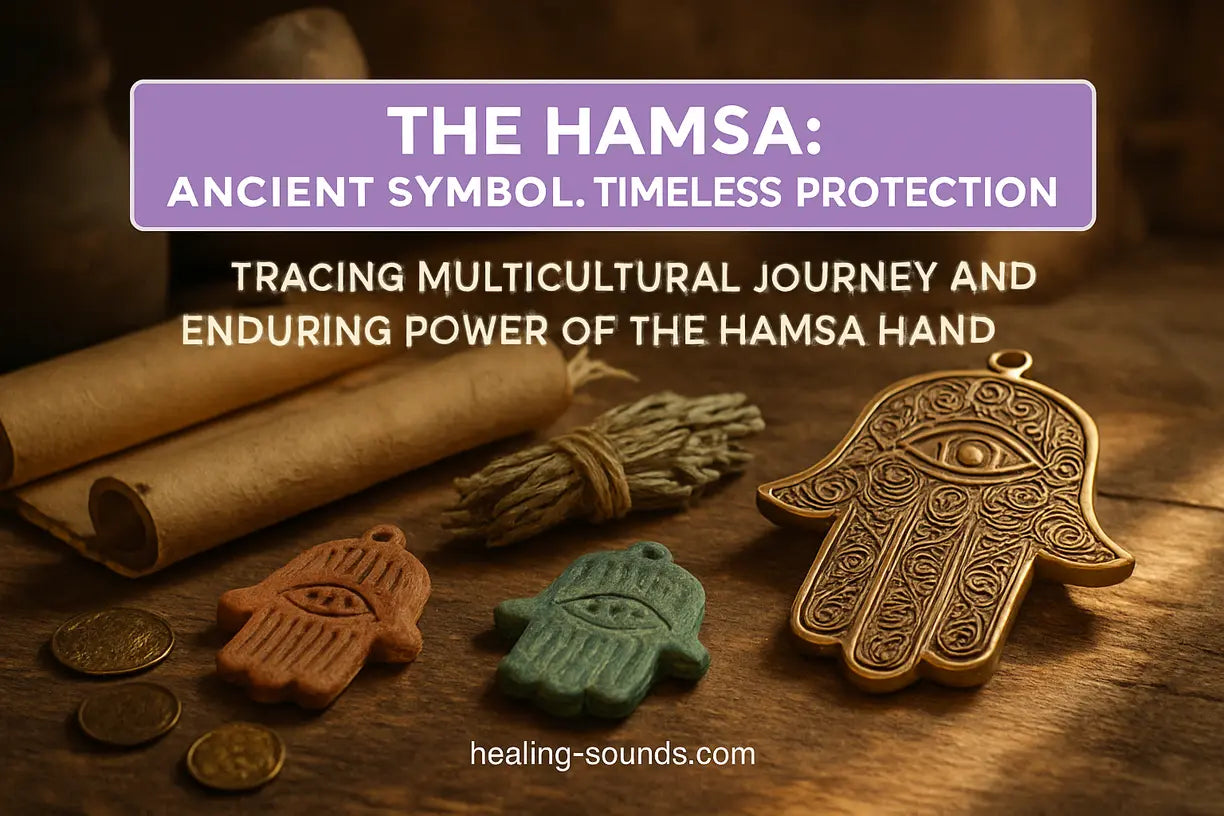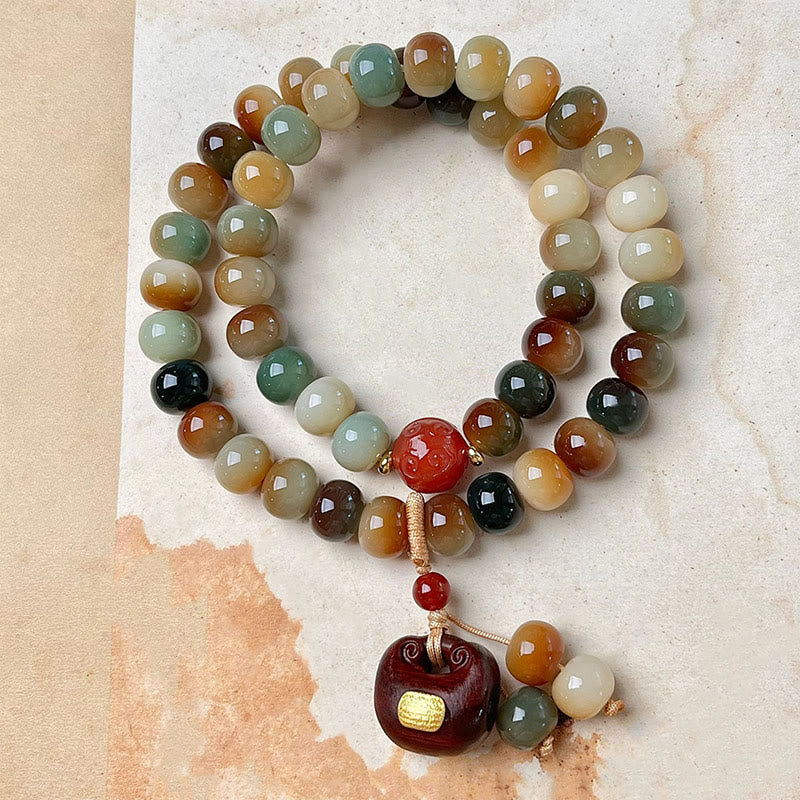Die Hamsa-Hand, ein weltweit bekanntes Symbol, strahlt eine Aura des Mysteriums, des Schutzes und uralter Weisheit aus. Für spirituell Interessierte ist das Verständnis ihres Ursprungs wie die Entdeckung einer verborgenen Karte, die sich durch Zivilisationen und Glaubensrichtungen zieht. Dieses rätselhafte, handförmige Amulett, oft mit einem Auge verziert, fasziniert seit Jahrtausenden die Herzen und Köpfe. Doch wo begann seine Reise? Dieser Artikel befasst sich mit dem faszinierenden Ursprung und der Geschichte der Hamsa , erforscht ihre antiken Wurzeln und wie sie zu einem geschätzten Emblem in verschiedenen Kulturen wurde. Begeben Sie sich auf eine Zeitreise und entdecken Sie die Bedeutungsebenen dieses kraftvollen Symbols.
Was ist die Hamsa-Hand? Ein Einblick in ihre Bedeutung
Bevor wir den Ursprung der Hamsa-Hand erforschen, wollen wir kurz auf ihre allgemeine Bedeutung eingehen. Die Hamsa, auch bekannt als Khamsa, Chamsa oder Hand der Fatima, ist in erster Linie ein Schutzzeichen. Man glaubt, sie wehre den bösen Blick ab und bringe ihrem Besitzer Güte, Überfluss, Fruchtbarkeit, Glück und Gesundheit. Das Wort „Hamsa“ selbst bedeutet auf Arabisch „fünf“ und bezieht sich auf die fünf Finger der Hand. Obwohl ihre Gestaltung variieren kann und typischerweise eine offene rechte Hand zeigt, oft mit einem Auge in der Handfläche, ist ihr Hauptzweck als Schutztalisman im Laufe ihrer langen Geschichte bemerkenswert konstant geblieben.
Die antike Wiege: Die Ursprünge der Hamsa in Mesopotamien
Die frühesten Wurzeln des Hamsa-Symbols liegen vermutlich im alten Mesopotamien, der Wiege der Zivilisation. Archäologische Funde deuten darauf hin, dass Symbole einer offenen rechten Hand schon lange vor ihrer Übernahme durch die großen Religionen als Schutzamulette verwendet wurden. Figuren wie die Hand der Ishtar (oder Inanna), einer mesopotamischen Göttin, die mit Liebe, Schönheit, Krieg und Fruchtbarkeit in Verbindung gebracht wird, gelten als mögliche Vorläufer. Diese frühen Handsymbole wurden um göttlichen Schutz und Segen angerufen. Die Reise dieses kraftvollen Emblems von seinen mesopotamischen Anfängen bis zu seiner weltweiten Präsenz unterstreicht seine anhaltende Anziehungskraft und seine universelle Botschaft des Schutzes.

Um die Ursprünge der Hamsa zu verstehen, muss man diese tiefen historischen Zusammenhänge anerkennen, die vielen modernen Interpretationen vorausgehen. Es zeigt, wie lange die Menschheit nach Symbolen des Schutzes und der göttlichen Gunst gesucht hat. Zur weiteren Erforschung der mesopotamischen Symbolik bieten Quellen wie die Essays des Metropolitan Museum of Art über mesopotamische Kunst wertvolle Einblicke.
Die Reise der Hamsa durch die Kulturen
Von seinen mesopotamischen Wurzeln aus begann das Symbol der schützenden Hand seine Wanderung durch verschiedene Kulturen und Zivilisationen im alten Nahen Osten und im Mittelmeerraum.
Echos im alten Ägypten und der Levante
Im alten Ägypten diente das zweifingrige Amulett, das die Finger des Horus darstellte, zum Schutz. Obwohl es sich von der fünffingrigen Hamsa unterschied, war das Konzept einer göttlichen Hand, die Schutz bot, präsent. Im gesamten Nahen Osten, einschließlich Phönizien, erschien das Handsymbol auf Amuletten und Artefakten, oft in Verbindung mit lokalen Gottheiten und Schutzgeistern. Diese frühen Übernahmen zeigen die Anpassungsfähigkeit des Symbols und seinen wachsenden Ruf als wirksames Talisman gegen bösartige Mächte.
Die Hand von Tanit in Karthago
Eines der bedeutendsten frühen Vorkommen eines Hamsa-ähnlichen Symbols ist die Hand der Tanit, der Hauptgöttin Karthagos. Tanit war eine punische und phönizische Gottheit, die Gemahlin von Baal Hammon, und wurde als Beschützerin der Stadt und Symbol der Fruchtbarkeit verehrt. Karthagische Stelen und Amulette zeigten häufig eine offene rechte Hand, was den antiken Glauben an ihre Schutzkräfte unterstreicht. Die weite Verbreitung in der karthagischen Kultur festigte den Platz des Handsymbols in der spirituellen Ikonographie der Antike.
Wichtige Erkenntnisse zu Hamsas Reise in die Antike:
- Mesopotamien: Früheste Belege für Handsymbole zum Schutz (z. B. Hand der Ishtar).
- Antike Levante und Ägypten: Ähnliche Konzepte göttlicher Hände, die Schutz bieten.
- Karthago: Bekannte Verwendung als „Hand von Tanit“, einer wichtigen Schutzgottheit.
Die Hamsa in allen Glaubensrichtungen: Ein Symbol der Einheit und Unterscheidung
Mit dem Aufstieg und Untergang von Imperien und der Entstehung neuer Religionen wurde das alte Handsymbol übernommen und neu interpretiert. Es fand einen bedeutenden Platz in den abrahamitischen Religionen und darüber hinaus. Seine universelle Anziehungskraft ermöglichte es ihm, über bestimmte Lehren hinauszugehen und zu einem gemeinsamen Symbol göttlicher Präsenz und Schutzes zu werden.
Die Hamsa im Judentum: Eine Hand des göttlichen Schutzes
In der jüdischen Tradition wird die Hamsa oft als „Hand Mirjams“ bezeichnet, in Anlehnung an Mirjam, die Schwester von Moses und Aaron. Ihre fünf Finger werden manchmal als Symbol der fünf Bücher der Thora interpretiert. Die Hamsa-Hand gilt im Judentum als Schutzsymbol, insbesondere vor dem bösen Blick (Ajin Hara), und wird auch als Glücks- und Segensbringer angesehen. Sie ist ein häufiges Motiv in jüdischer Kunst, Schmuck und Wohnkultur und erinnert an Gottes schützende Hand. Der jüdische Ursprung der Hamsa ist tief in kulturellen und mystischen Traditionen verwurzelt und beruht nicht auf einem expliziten biblischen Gebot. Sie hat sich über Jahrhunderte zu einem beliebten Volkssymbol entwickelt. Weitere Informationen zur jüdischen Symbolik finden Sie in maßgeblichen Quellen wie My Jewish Learning .
Die Hand der Fatima im Islam
Im Islam ist die Hamsa weithin als „Hand der Fatima“ bekannt, benannt nach Fatima Zahra, der Tochter des Propheten Mohammed. Die fünf Finger werden manchmal mit den fünf Säulen des Islam in Verbindung gebracht. Wie in anderen Traditionen gilt sie vor allem als wirksames Amulett zum Schutz vor dem bösen Blick (Nazar) und soll Segen, Kraft und Glück bringen. Die Hand der Fatima ist ein weit verbreitetes Symbol in vielen muslimischen Kulturen und findet sich in Schmuck, Haushaltsdekorationen und sogar an Türen, um das Haus zu schützen.
Die Hamsa und das Christentum: Den Zusammenhang verstehen
Die Frage nach dem Ursprung der Hamsa im Christentum und ihrer Vereinbarkeit mit dem Christentum stellt sich häufig. Historisch gesehen ist die Hamsa kein traditionelles christliches Symbol. Ihre Wurzeln liegen in der vorchristlichen Zeit, in den alten Kulturen des Nahen Ostens, und wurden später maßgeblich vom Judentum und Islam übernommen. Während manche Christen, insbesondere in Regionen mit historischen Wechselwirkungen zwischen diesen Glaubensrichtungen (wie dem Nahen Osten oder Teilen des Mittelmeerraums), sie als kulturellen Glücksbringer oder aufgrund ihrer ästhetischen Anziehungskraft tragen, hat sie in der gängigen christlichen Lehre keine inhärente theologische Bedeutung. Einige Konfessionen raten sogar von ihrer Verwendung ab, wenn sie als abergläubisches Objekt wahrgenommen wird. Daher ist die Bedeutung der Hamsa-Hand für das Christentum eher eine Frage kultureller Übernahme oder persönlicher Interpretation als ein etabliertes religiöses Emblem.
Missverständnisse ausräumen: Ist die Hamsa heidnisch oder hinduistisch?
Angesichts ihrer antiken Wurzeln wird oft nach einem heidnischen Ursprung der Hamsa gefragt. Tatsächlich liegen ihre mesopotamischen und karthagischen Ursprünge vor den großen monotheistischen Religionen, sodass ihre frühesten Formen den damals als heidnisch geltenden Glaubenssystemen zuzuordnen sind. Ihre spätere Integration in Judentum und Islam veränderte jedoch für viele ihre primäre Assoziation. Was die Frage „Ist die Hamsa ein hinduistisches Symbol?“ betrifft, so ist die Hamsa traditionell kein zentrales Symbol im Hinduismus, der über eine eigene reiche Palette göttlicher Handgesten (Mudras) und Schutzsymbole verfügt. Obwohl einige visuelle Ähnlichkeiten bestehen mögen, unterscheiden sich die spezifische historische Entwicklung und die kulturelle Namensgebung der Hamsa (Hand der Miriam, Hand der Fatima) von der hinduistischen Ikonographie.
Die anhaltende Kraft der Hamsa: Mehr als nur ein Amulett
Die Reise der Hamsa durch Jahrtausende und über Kontinente hinweg spricht Bände über ihre tiefe Symbolik. Sie ist ein Zeugnis für das gemeinsame menschliche Verlangen nach Schutz, Segen und der Verbindung zu etwas Größerem. Ob als Hand Gottes, Miriam, Fatima oder antike Göttin – die Hamsa ist nach wie vor ein kraftvolles Symbol der Hoffnung und Widerstandsfähigkeit .

Heute tragen viele Menschen Hamsa-Schmuck oder stellen ihn zu Hause aus – nicht nur wegen seiner vermeintlichen Schutzwirkung, sondern auch aus Wertschätzung seiner reichen Geschichte und multikulturellen Bedeutung. Er erinnert uns an die Verbundenheit menschlicher Glaubenssysteme und die zeitlose Anziehungskraft von Symbolen, die unser tiefstes Verlangen nach Sicherheit und Wohlbefinden ansprechen.
Mehrlagiges Lederarmband mit Evil Eye Charm - Verstellbar Unisex
$29.99 $39.99
Bekennen Sie sich zum Erbe der Hamsa mit diesem farbenfrohen Wickelarmband mit dem bösen Blick, das traditionellen Schutz mit modernem Boho-Stil verbindet.
Produkt entdeckenSymbolik, die durch die Zeit getragen wird
Die Geschichte der Hamsa ist von bemerkenswerter kultureller Beständigkeit geprägt. Von antiken Schnitzereien bis hin zu modernen Accessoires variiert ihre Form, doch ihr Wesen als Schutz- und Glücksbringer bleibt erhalten. Die komplizierten Designs enthalten oft weitere Schutzsymbole wie das Auge, den Fisch (ein Symbol für Glück und Fruchtbarkeit) oder den Davidstern, was ihre wahrgenommene Kraft noch verstärkt. Diese Anpassungsfähigkeit hat dazu geführt, dass die Hamsa-Hand in zeitgenössischen spirituellen Praktiken und als modisches Statement mit tiefer Bedeutung weiterhin relevant und geschätzt ist.

Kernsymbolik der Hamsa in allen Traditionen:
- Schutz: Vor allem gegen den bösen Blick und negative Energien.
- Segen: Soll Glück, Freude, Gesundheit und Wohlstand bringen.
- Stärke und Kraft: Steht für göttliche Präsenz und Stärke.
- Fruchtbarkeit und Überfluss: Besonders in älteren Interpretationen.
Schmücken Sie sich mit zeitlosen Schutzsymbolen
$35.90
$51.90
Verbinden Sie sich mit diesem eleganten Armband aus roter Schnur mit alten Schutztraditionen, perfekt, um täglich spirituelle Symbolik zu ehren. Mehr erfahren ➔
$24.90
$35.90
Als achtsames Amulett getragen, ruft dieses Bodhi-Samen-Armband Harmonie und Weisheit hervor und kanalisiert zeitlose Traditionen der Wurzeln der Hamsa. Mehr erfahren ➔
Fazit: Das zeitlose Erbe der Hamsa
Der Ursprung der Hamsa ist ein reiches Geflecht aus Fäden antiker mesopotamischer Spiritualität, karthagischer Ehrfurcht, jüdischer Mystik, islamischem Glauben und breiter kultureller Übernahme. Ihre Reise durch die Geschichte offenbart ein Symbol, das nicht auf ein einzelnes Glaubenssystem beschränkt ist, sondern vielmehr ein universelles menschliches Verlangen nach Schutz, Verbundenheit und göttlichem Segen anspricht. Das Verständnis der vielfältigen Ursprünge der Hamsa und der tiefen Herkunft der Hamsa-Hand bereichert ihre Bedeutung und verwandelt sie von einem bloßen Ornament in ein kraftvolles Symbol gemeinsamen menschlichen Erbes. Da sie weltweit nach wie vor geschätzt wird, ist die Hamsa ein Beweis für die anhaltende Kraft von Symbolen, Hoffnung zu vermitteln und über Generationen hinweg den Geist zu schützen.
Durch die Wertschätzung seiner Geschichte verbinden wir uns tiefer mit den Traditionen, die dieses Symbol seit Jahrhunderten verehren. Ob Sie sich von seinen schützenden Eigenschaften oder seinem schönen Design angezogen fühlen, das Wissen um die alten Wurzeln der Hamsa verleiht diesem beliebten Amulett eine zusätzliche Bedeutungsebene. Entdecken Sie unsere Kollektion bei Healing Sounds und finden Sie ein Hamsa-Stück, das Ihren Geist berührt und dieses zeitlose Erbe weiterträgt.
Häufig gestellte Fragen zu Hamsa – Herkunft und Geschichte
Die frühesten Ursprünge der Hamsa gehen auf das alte Mesopotamien zurück, wo Handsymbole zum Schutz verwendet wurden. Später tauchte sie in der karthagischen Kultur als Hand der Tanit auf und wurde anschließend vom Judentum (als Hand der Miriam) und dem Islam (als Hand der Fatima) übernommen und neu interpretiert.
Die Hamsa ist kein traditionelles christliches Symbol und hat im Christentum keine spezifische theologische Bedeutung. Ihre Ursprünge liegen in der vorchristlichen Zeit. Manche Christen tragen sie zwar aus kulturellen Gründen oder als Glücksbringer, insbesondere in Regionen mit gemischtem religiösen Erbe, doch ist sie kein offizielles christliches Emblem. Einige Konfessionen raten von ihrer Verwendung ab, da sie Bedenken hinsichtlich Synkretismus oder Aberglauben haben.
Die Hamsa ist kein traditionelles hinduistisches Symbol . Der Hinduismus verfügt über eine eigene, reichhaltige Ikonographie, darunter verschiedene Handgesten (Mudras) mit spezifischen spirituellen Bedeutungen. Die historische Entwicklung und die kulturellen Namen der Hamsa (Hand der Miriam, Hand der Fatima) unterscheiden sich von den hinduistischen Traditionen, da ihre Wurzeln im Nahen Osten und Nordafrika liegen.
Das Hamsa-Symbol (🪬) hat in der christlichen Theologie keine eigene Bedeutung . Wie bereits erwähnt, liegen seine Ursprünge außerhalb des Christentums. Wenn ein Christ das Symbol verwendet oder ihm begegnet, beruht seine Bedeutung wahrscheinlich eher auf seinem allgemeinen kulturellen Verständnis als Schutzamulett oder Glückssymbol als auf einer spezifischen christlichen Lehre.
Im Judentum hat die Hamsa, oft auch Hand Mirjams (der Schwester von Moses und Aaron) genannt, eine lange Geschichte als Schutzamulett gegen den bösen Blick (Ajin Hara). Ihre fünf Finger werden manchmal mit den fünf Büchern der Thora in Verbindung gebracht. Obwohl es in der Heiligen Schrift nicht vorgeschrieben ist, wurde sie zu einem wichtigen Teil der jüdischen Volkstradition und der kabbalistischen Symbolik und steht für göttlichen Schutz, Glück und Segen.






